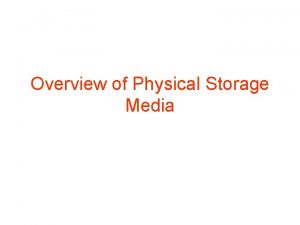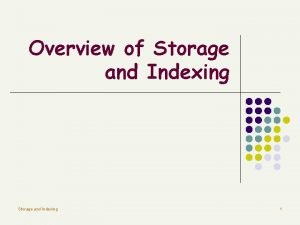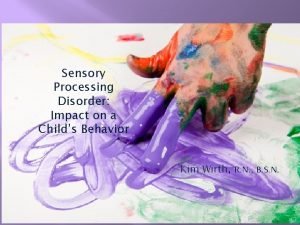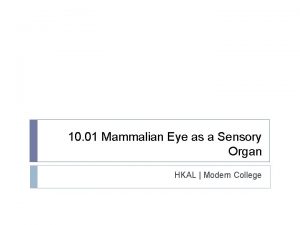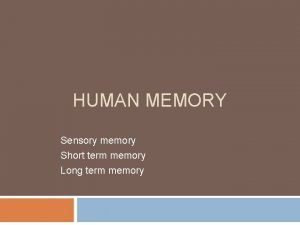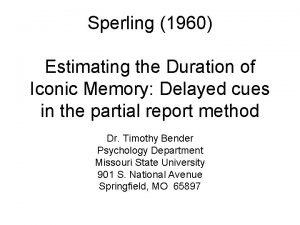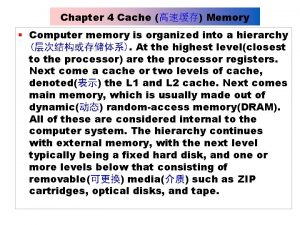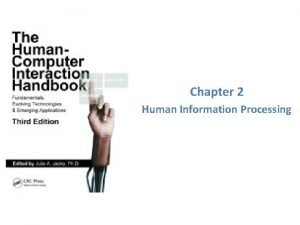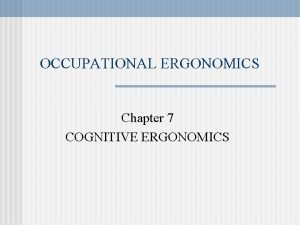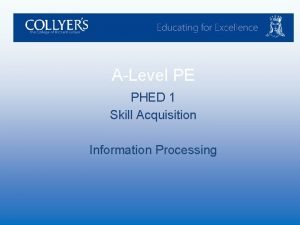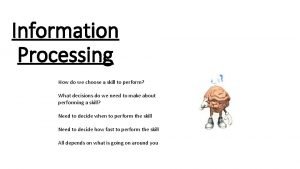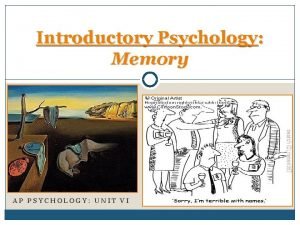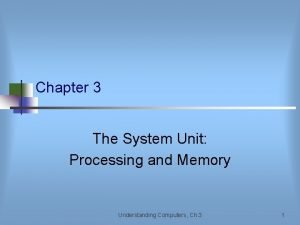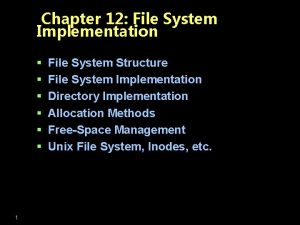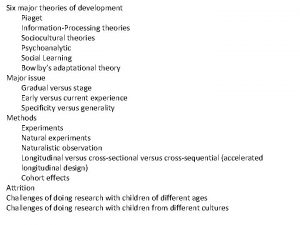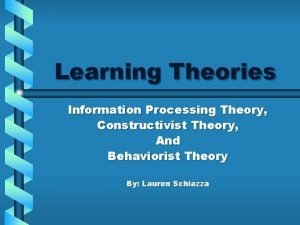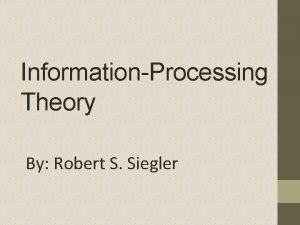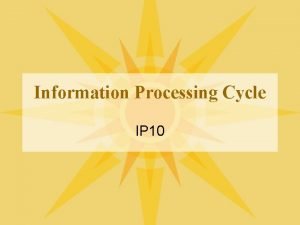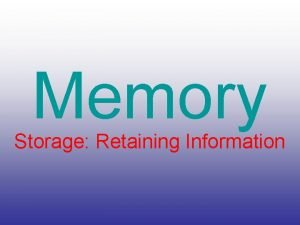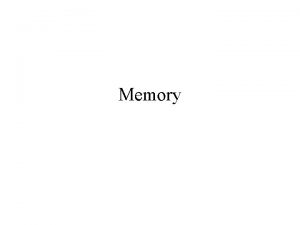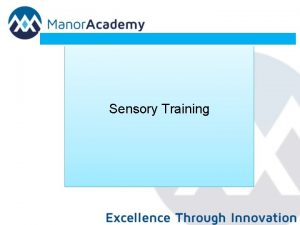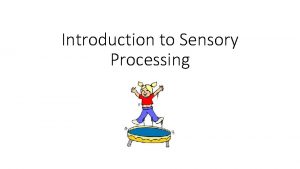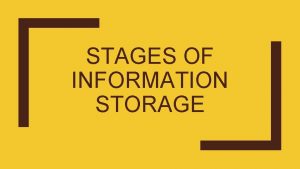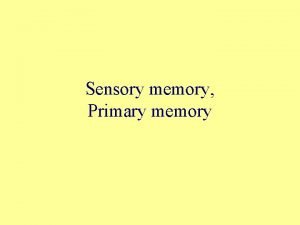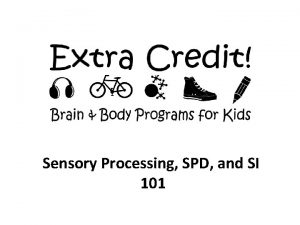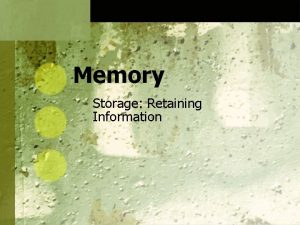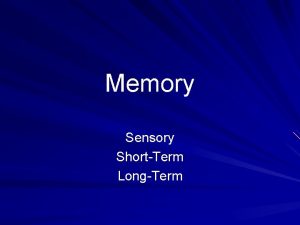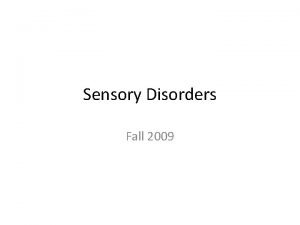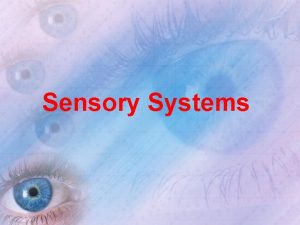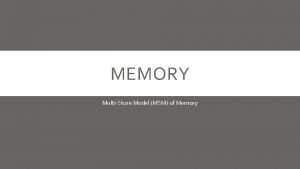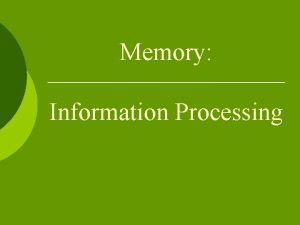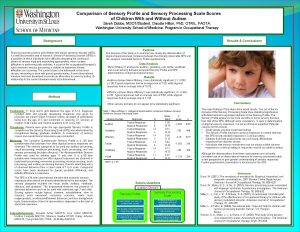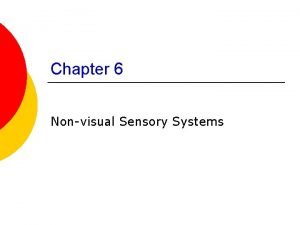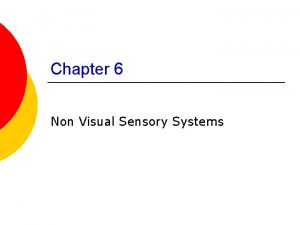Memory Memory Overview Information Processing Model Sensory Storage




















































- Slides: 52

Memory

Memory Overview: Information Processing Model

• Sensory Storage – Capacity: large – Duration: very brief – Peripheral • STM – Capacity: small – Duration: brief unless rehearsed – Central • LTM – Capacity: large – Duration: indefinitely long – Central

Memory: Parts (Systems) • At least 3 storage mechanisms, or systems: SS, STM, LTM • Perhaps many subsystems within LTM as well? • Separate Implicit and Explicit systems?

Memory: Processes • Encoding • Storage • Retrieval • Memory can fail at any of these 3 points

Memory: Creating It (Encoding Tasks) • Intentional • Incidental

Memory: Measuring It (Retrieval Tasks) • Recognition (direct, explicit) • Recall (direct, explicit) o Free Recall o Ordered Recall o Cued Recall • Priming (indirect, implicit) o Stem Completion o Free Association o Lexical Decision

Sensory Storage: the Icon • Span of apprehension • Sperling’s Partial Report Technique • Implications for Capacity of Sensory Storage – Unlimited Capacity for Icon – Rapid Decay • Demonstration: partial, then full report

A G L U T R Y K Q


B H M E P W J L I


Capacity of the Icon Pattern of Results with Short Retention Interval (less than 250 ms) Partial Report Full Report

Short-Term Memory • Duration: <18 seconds (without rehearsal) – Maintenance Rehearsal – Elaborative Rehearsal • Capacity: 7+-2 (Miller, 1956) • Chunking – 8 6 7 5 3 0 9 3 1 2 vs. – 867 5309 312

Retrieval from STM • • Saul Sternberg: Additive Factors Memory set of 1 to 6 items Probe item: RT to say “yes” or “no” Does RT increase as a function of memory set size? • Are you faster to say “yes” than “no”?

Possible Results of Sternberg Task No Yes Parallel Search Serial Exhaustive Search Serial Self-Terminating Search

Actual Results for Sternberg Search • Serial Exhaustive Search: – RT increased by 38 ms per item – No difference for “yes” vs. “no” • Why not self-terminating? Wouldn’t that be more efficient?

Encoding in STM • Primarily Auditory / Phonological – Sound-based errors in recall of visually presented letters (Conrad, 1964) – More words can be recalled if they are short (fast to be pronounced) (Baddeley, Thomson, & Buchanan, 1975) • Visual – Letter matching: AA faster than Aa with ISI of 2 seconds or less (Posner & Keele, 1967) • Semantic – Release from Proactive Interference (Wickens, 1970)

Forgetting from STM • Displacement or Decay? • Decay: Peterson & Peterson • Displacement: (Waugh & Norman, 1965) – Immediate memory for digits: What followed the first instance of the digit before the tone? – Presentation rate: 1/second vs. 4/second – Accuracy decreases as a function of number of intervening items, but not related to delay

STM as Processing and Storage: “Working Memory” • Working Memory = the "desktop" or "workbench" of cognitive processes • 3 components: – Central Executive – 2 “Slave” Systems: • Phonological Loop – Phonological Store (2 seconds) – Articulatory Control Process • Visuo-Spatial Scratchpad

Evidence for the Working Memory Model • Baddeley & Hitch, 1974 • Dual Task: – Memory Load (0 to 6 letters) – Reasoning Task (true/false) • Instructions emphasized one task or the other • Did the tasks interfere with each other?

Results (Baddeley & Hitch, 1974)

Classic Memory Phenomena • The Forgetting Curve – Ebbinghaus • The Serial Position Effect – Primacy – Recency

The Serial Position Effect • Occurs over both short and long retention intervals – Memory for US presidents • Greater recency effect for auditory than visual presentation • Suffix Effect – hearing another spoken word after the last item in the list reduces recency

Example of Suffix Effect • I S Q K M P W Y D “go” (with suffix) • U A L N C G F O Z [clap] (no suffix)

Explaining the Serial Position Effect • LTM, STM • Interference • Temporal Distinctiveness

Long Term Memory • Processing Theories • Systems Theories • Reliability and Strategies

LTM: Processing Theories • Levels of Processing (encoding) • Encoding Specificity (encoding & retrieval)

Levels of Processing (Craik & Lockhart, 1972) • “Deeper” processing at encoding = better remembered • Evidence: – Maintenance rehearsal does not improve recall (Craik & Watkins, 1973) – Deeper processing increases recall (Rogers, Kuiper, & Kirker, 1977) o o Structural: capital letters? Phonemic: rhymes with? Semantic: means same as? Self-reference: describes you?

Encoding Specificity • Match between encoding and retrieval determines how well remembered • Matching Contexts (Gooden & Badeley, 1975) • Matching Processing – “Transfer-Appropriate Processing” – (Morris, Bransford, & Franks, 1977)

Morris, Bransford, & Franks, 1977 • Study Task example: “train” – Shallow: “Rhymes with drain? ” – Deep: fits “The ___ has a silver engine? ” • Retrieval Task – Shallow: “Rhymes with a studied word? ” – Deep: “Is this a studied word? ”

Predictions: Levels of Processing and Encoding Specificity Encoding Task Retrieval Task Shallow (rhyming recog. ) Deep (recognition) Shallow (rhyme) Deep (sentence frame)

LTM: Systems • • Procedural vs. Declarative Episodic vs. Semantic Explicit vs. Implicit Multiple Memory Systems

Semantic Memory • Hierarchical Model (Collins & Quillian 1969, 1972) – Hierarchical Organization – Evidence: animal • “A canary is a bird” vs. • “A canary is an animal” bird fish – Problem: typicality effects • “A canary is a bird” vs. • “An emu is a bird” emu canary

Semantic Memory • Spreading Activation Model (Collins & Loftus, 1975) – Modification of Hierarchical Model animal – Link length = strength of association (inverse) bird emu fish canary

Semantic Memory: Schemas o Schema = a model of the world that we use to remember and make sense of things. o an organized unit of knowledge o embodies typical expectations of situations, events, people o has slots that can be filled in with default values • Examples: – Restaurant Script (Schank & Abelson, 1975) – Stereotypes

Schemas and Reconstructive Memory • Schemas at encoding: filters • Schemas at retrieval: scaffolds • Reconstructive Memory: Bartlett, 1932 – “War of the Ghosts” story – Distortions in free recall • Schema plus Correction Model of memory (Smith & Graesser, 1981)

Episodic Memory • • Memory for specific events (place & time) A surprising effect: Recognition Failure A mathematical model: SAM A distinct neural system? The hippocampus and anterograde amnesia

Recognition Failure: When recall is superior to recognition (Tulving & Thomson, 1973; Watkins & Tulving 1975) • study: glue-CHAIR (weakly associated words) • recognition test: desk, top, chair (Target word is not recognized in the different context. ) • cued recall: glue _______ (Chair is recalled when the retrieval cue matches the encoding context. )

SAM – a mathematical model • A “Global Memory Model” • Purposes of a Model – Make theoretical assumptions explicit – Fit existing data – Predict novel findings • A Simplified Description of SAM • A working Demo of SAM (by Ian Neath)

A Neural Mechanism for Forming Episodic Memories? • Damage to the hippocampus and surrounding areas often results in anterograde amnesia (such as H. M. ) • New episodic memories are not formed (recognition and recall) • New “implicit” memories are intact (priming)

Implicit Memory: A Separate Memory System? • Spared implicit memory in amnesia • “Double-dissociation” of explicit (episodic) memory and implicit memory (priming) – Manipulations that affect explicit memory (e. g. , depth of processing) do not affect implicit memory – Manipulations that affect implicit memory (e. g. , physical similarity) do not affect explicit memory – Some tasks (e. g. , generation effect, Jacoby 1983) have opposite effects on the two types of memory tests

Multiple Memory Systems • • Semantic Episodic Procedural “Perceptual Representation Systems” (implicit memory systems) – Visual Word Form system – Structural Description System – Pre-semantic Auditory Subsystem

Alternatives to Multiple Systems • Implicit memory as perceptual bias (Ratcliff, Mc. Koon, & Allbritton, 1997) • Transfer-appropriate processing as an alternative explanation for dissociations (Roediger, 1990) – – Data-driven vs. Conceptually Driven Processing “Implicit” tasks are typically data-driven “Explicit” tasks are typically conceptually driven Crossing the two types of processing at encoding and retrieval produced an “encoding specificity” type of pattern of results.

Failures of Memory • Sources of Forgetting – Decay – Interference – Poor retrieval cues (think encoding specificity) • Massed vs. Distributed Practice: Which is better? Why? • Sources of Distortion – Schemas – Post-event information

Eye-witness Memory: How Reliable is It? • John Dean’s memory and the Nixon tapes • Loftus: The influence of Post-event information – Remembering things that were not there (“How fast when they smashed into each other? ”) – Blending real and post-event information (see blue car; asked about green, remember aqua)

Is a Memory Real? Can you tell? • More Confident? (no) (Loftus, Donders, Hoffman, & Schooler, 1989) • More Detailed (no) (Schooler, Gerhard, Loftus, 1986) • More resistant to contradiction? (no) (Loftus, Korf & Schooler 1989)

Repressed Memories vs. False Memory Syndrome • • Recovered Memory Experiences The theory of repression The role of hypnosis A dangerous assumption: "The abuse in your life is always as great as the emotional pain you suffer now. . . If your pain is extreme, the abuse must have been severe, and if you don't remember being abused, you must have repressed it. “ • from Bass & David, The Courage to Heal, 1988

False Recognition & Famous Overnight • (Jacoby, Kelley, & Dywan, 1989; Jacoby, Woloshyn, & Kelley, 1989) • Recognition judgments depend on attributing perceptual fluency to having been studied • A Signal Detection Analysis framework can be used to understand recognition judgments • If perceptual fluency is increased by other means (such as subliminal priming during the test), fluency may be above threshold, leading to false alarms (false memory). Fluency is misattributed to the word’s having been studied. [Class data from Coglab] • In the “famous overnight” effect, perceptual fluency is misattributed to fame rather than to having been studied.

Meta-memory • But we do sometimes have reliable intuitions about our memory: – Tip of the Tongue – Feeling of Knowing judgments • Correlated with recognition performance

Memory Strategies • Mnemonics – Method of Loci – Peg-word Method – Acronyms (unruly goldfish sideburns) • Encoding Specificity – Context – Multiple cues • Depth of Processing – Adequate encoding – Maintenance vs. elaborative rehearsal

 Physical storage devices
Physical storage devices Overview of storage and indexing
Overview of storage and indexing Sensory processing disorder dsm
Sensory processing disorder dsm Asd levels
Asd levels Sequence of sensory processing
Sequence of sensory processing Atranu
Atranu Sperling 1960 sensory memory
Sperling 1960 sensory memory Modified three stage processing model of memory
Modified three stage processing model of memory Computer memory system overview
Computer memory system overview Computer memory system overview
Computer memory system overview Primary storage and secondary storage
Primary storage and secondary storage Primary storage and secondary storage
Primary storage and secondary storage Uses rigid metallic platters
Uses rigid metallic platters Object based and unified storage
Object based and unified storage Human information processing hci
Human information processing hci Human information processing model ergonomics
Human information processing model ergonomics Whiting's model of information processing
Whiting's model of information processing Welfords model
Welfords model Context dependent memory ap psychology
Context dependent memory ap psychology Short term memory computer
Short term memory computer Top-down vs bottom-up processing
Top-down vs bottom-up processing Bottom up processing vs top down processing
Bottom up processing vs top down processing Bottom up processing example
Bottom up processing example Point processing and neighbourhood processing
Point processing and neighbourhood processing Secondary processing of wheat
Secondary processing of wheat Point processing in image processing
Point processing in image processing Histogram processing in digital image processing
Histogram processing in digital image processing Parallel processing vs concurrent processing
Parallel processing vs concurrent processing A generalization of unsharp masking is
A generalization of unsharp masking is Point processing
Point processing Thinning and thickening in image processing example
Thinning and thickening in image processing example Top-down processing
Top-down processing What is interactive processing
What is interactive processing Loftus experiment
Loftus experiment The system unit processing and memory
The system unit processing and memory In-memory file system
In-memory file system Emc information storage and management
Emc information storage and management Semantic features definition
Semantic features definition Difference between implicit and explicit memory
Difference between implicit and explicit memory Long term memory vs short term memory
Long term memory vs short term memory Internal memory and external memory
Internal memory and external memory Primary memory and secondary memory
Primary memory and secondary memory Logical address
Logical address Which memory is the actual working memory?
Which memory is the actual working memory? Virtual memory and cache memory
Virtual memory and cache memory Virtual memory in memory hierarchy consists of
Virtual memory in memory hierarchy consists of Eidetic memory vs iconic memory
Eidetic memory vs iconic memory Symmetric shared memory architecture
Symmetric shared memory architecture Vygosky theory
Vygosky theory Information processing theory
Information processing theory Types of internal control
Types of internal control What is the information processing theory
What is the information processing theory Ip cycle
Ip cycle
